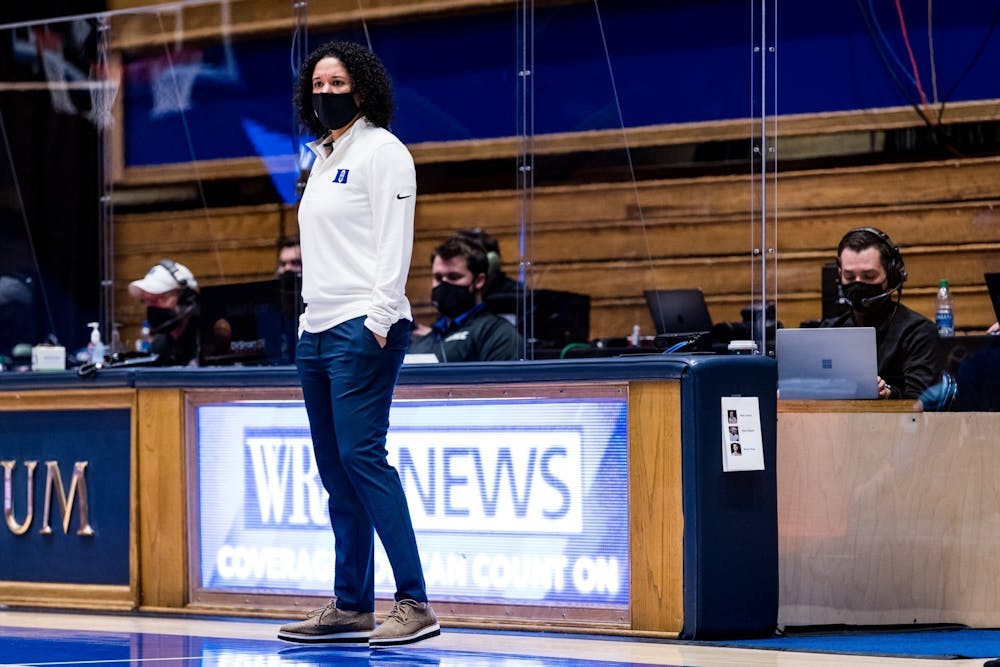When Kara Lawson was hired last summer, I wrote that Duke was “just a few good years away from returning to ACC title contention.” I figured that might be generous. Turns out I was too pessimistic.
In just nine months, Duke women’s basketball has been born anew. The program that went to 11 Elite Eights in 16 years between 1998 and 2013 had finished 10th in the ACC in 2018-19 and was picked to finish there again this past preseason. The talent that had powered a surprise run to a third-place ACC finish in 2019-20 left last summer, and tough times looked to be ahead. Lawson’s hiring instilled new excitement in the program, but it seemed that Courtney Banghart’s job at North Carolina was Lawson’s best-case scenario: a rough first couple of years while hoping the recruiting reaches the elite level ahead of schedule. A 24-point November loss to Louisville suggested that that first year was indeed going to be painful.
That first season was soon cancelled, though, due to COVID-19 concerns, leading to the early start of a busy offseason. Just a week later, the team made a surprising addition of Nyah Green, a former five-star recruit and Louisville Cardinal. While six players transferred out of Duke by mid-March, all six were replaced by the end of April. Lawson added six new recruits during the month, including five more former five-stars, with the team upgrading massively across the board.
In just nine months, the Blue Devils have gone from an ACC cellar-dweller to an inarguable top-five squad in one of the toughest conferences in the country. For my money, Duke could be the second-best team in the ACC next year, making this its best season since 2016-17.
Let’s look at what Duke brings to the court next year. The first thing that jumps out about the roster is how adaptable it is.
“We wanted to be aggressive in going after players that fit how we want to play,” Lawson told GoDuke.com. “There are a couple things that we value highly. One is versatility. The other is two-way players—players that can make an impact on both ends. All of these players can do that."
The Blue Devils go about two-deep at every position, including three players who can play either guard or wing (Celeste Taylor, Miela Goodchild, Lee Volker), three who can play wing or forward (Lexi Gordon, Elizabeth Balogun, Green) and two who can play both forward and center (Imani Lewis and Onome Akinbode-James), plus a combo guard in Vanessa de Jesus. The rotation, likely to go 11 or 12-deep in the regular season, features five great shooters, six excellent defenders and only a couple players who are not definite two-way contributors.
Duke’s backcourt next year features a former freshman phenom in de Jesus, a slasher in Taylor, a standout defender and offensive enigma in Jordyn Oliver and a 3-and-D star in Goodchild. With de Jesus able to play at either guard spot, pairs of them can be mixed and matched depending on the opponent; de Jesus and Taylor can play together to emphasize creation at the expense of some on-ball defense, Oliver and de Jesus can play together to add passing if Lawson can afford to give up size or Oliver and Goodchild could play together to add balance and on-ball defense at the expense of pull-up shooting.
Even more versatile is the Blue Devil frontcourt, consisting of Jade Williams, a top defender and offensive swiss army knife in Balogun, a versatile rim-runner in Akinbode-James, a midrange surgeon and elite rebounder in Lewis and a rim runner in Amaya Finklea-Guity. There are endless combinations based on the match-ups: Balogun and Williams can space and defend and hurt you from anywhere on the court, Lewis and Williams can be a great rebounding duo at the expense of defending in space, Balogun and Akinbode-James can play together in a five-out weave offense but give up rim protection or Akinbode-James and Finklea-Guity can share time in a supersized lineup.
Combine each of those backcourt and frontcourt combinations, plus one of the remaining wings, and there’s no one the Blue Devils can’t be ready for. But a talented team can’t be maximized without great coaching, of course.
Luckily for Duke, Lawson and her assistants have proven themselves as one of the dozen or so smartest crews in the country, even in just four games. There are few teams in the ACC whose positioning was more consistent than, whose cuts were as timely as, whose schemes were as advanced as the Blue Devils. Despite that staff taking over in late July, the team was running more professional schemes than most squads that had been together for years.
In just four games last fall, Duke ran slips, staggers, pin-downs and veers. It perfected one set play, then executed two different counters of it against then-No. 2 Louisville. It ran high drop coverage against middle pick-and-rolls, and ICE against side pick-and-rolls.
Now, recruiting through the transfer portal might seem like only a temporary way to build a team. But Lawson and co. aren’t trying to keep reaching for transfers; three players (Williams, Gordon and Finklea-Guity) graduate after this year, and are being replaced by at least three recruits, including two top-25 players in off-ball guard Ashlon Jackson and hybrid-forward Shay Bollin. And Duke is still a finalist for five top-30 prospects.
Last summer, I thought the Blue Devils wouldn’t see an NCAA tournament until after I’d graduate. But now, I wouldn’t be surprised at all if I’m watching them in the Final Four next April.
Get The Chronicle straight to your inbox
Sign up for our weekly newsletter. Cancel at any time.

